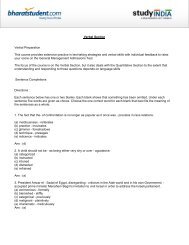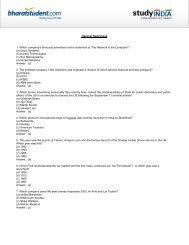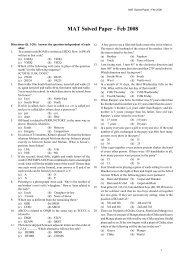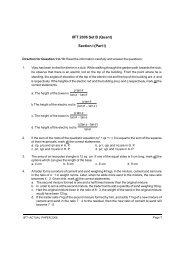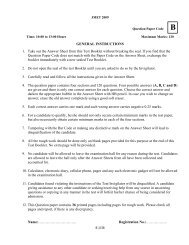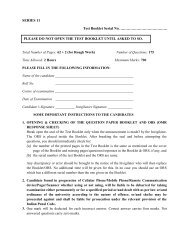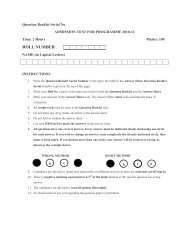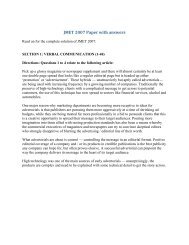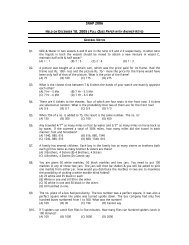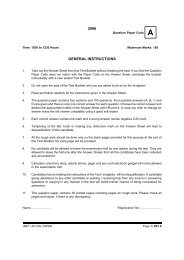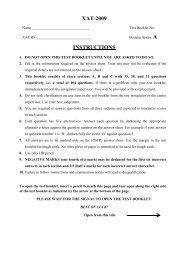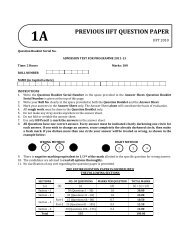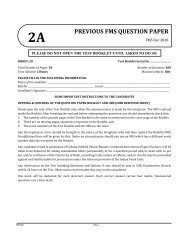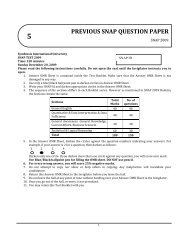CAT 2007 Question Paper - Testfunda
CAT 2007 Question Paper - Testfunda
CAT 2007 Question Paper - Testfunda
Create successful ePaper yourself
Turn your PDF publications into a flip-book with our unique Google optimized e-Paper software.
<strong>CAT</strong> <strong>2007</strong><br />
Section I<br />
This section contains 25 questions<br />
1. The price of Darjeeling tea (in rupees per kilogram) is 100 + 0.10 n, on the n th day of<br />
<strong>2007</strong> (n = 1, 2, ..., 100), and then remains constant. On the other hand, the price of<br />
Ooty tea (in rupees per kilogram) is 89 + 0.15n, on the n th day of <strong>2007</strong> (n = 1, 2, ...,<br />
365). On which date in <strong>2007</strong> will the prices of these two varieties of tea be equal?<br />
(1) May 21<br />
(2) April 11<br />
(3) May 20<br />
(4) April 10<br />
(5) June 30<br />
2. A quadratic function f(x) attains a maximum of 3 at x = 1. The value of the function at<br />
x = 0 is 1. What is the value of f(x) at x = 10?<br />
(1) –119<br />
(2) –159<br />
(3) –110<br />
(4) -180<br />
(5) -105<br />
3. Two circles with centres P and Q cut each other at two distinct points A and B. The<br />
circles have the same radii and neither P nor Q falls within the intersection of the<br />
circles. What is the smallest range that includes all possible values of the angle AQP<br />
in degrees?<br />
(1) Between 0 and 90<br />
(2) Between 0 and 30<br />
(3) Between 0 and 60<br />
(4) Between 0 and 75<br />
(5) Between 0 and 45<br />
Directions for <strong>Question</strong>s 4 and 5:<br />
Let S be the set of all pairs (i, j) where 1 ≤ i ≤ j < n and n ≥ 4. Any two distinct members of S<br />
are called “friends” if they have one constituent of the pairs in common and “enemies”<br />
otherwise. For example, if n = 4, then S = {(1, 2), (1, 3), (1, 4), (2, 3), (2, 4), (3, 4)}. Here, (1,<br />
2) and (1, 3) are friends, (1,2) and (2, 3) are also friends, but (1,4) and (2, 3) are enemies.<br />
4. For general n, how many enemies will each member of S have?<br />
(1) n – 3<br />
(2)<br />
(3) 2n – 7<br />
Page 1 of 30
(4)<br />
(5)<br />
<strong>CAT</strong> <strong>2007</strong><br />
5. For general n, consider any two members of S that are friends. How many other<br />
members of S will be common friends of both these members?<br />
(1)<br />
(2) 2n – 6<br />
(3)<br />
(4) n – 2<br />
(5)<br />
Directions for <strong>Question</strong>s 6 and 7:<br />
Shabnam is considering three alternatives to invest her surplus cash for a week. She wishes<br />
to guarantee maximum returns on her investment. She has three options, each of which can<br />
be utilized fully or partially in conjunction with others.<br />
Option A: Invest in a public sector bank. It promises a return of +0.10%<br />
Option B: Invest in mutual funds of ABC Ltd. A rise in the stock market will result in a<br />
return of +5%, while a fall will entail a return of –3%<br />
Option C: Invest in mutual funds of CBA Ltd. A rise in the stock market will result in a<br />
return of –2.5%, while a fall will entail a return of +2%<br />
6. The maximum guaranteed return to Shabnam is<br />
(1) 0.25%<br />
(2) 0.10%<br />
(3) 0.20%<br />
(4) 0.15%<br />
(5) 0.30%<br />
7. What strategy will maximize the guaranteed return to Shabnam?<br />
(1) 100% in option A<br />
(2) 36% in option B and 64% in option C<br />
(3) 64% in option B and 36% in option C<br />
(4) 1/3 in each of the three options<br />
(5) 30% in option A, 32% in option B and 38% in option C<br />
Page 2 of 30
Directions for <strong>Question</strong>s 8 and 9:<br />
<strong>CAT</strong> <strong>2007</strong><br />
Cities A and B are in different time zones. A is located 3000 km east of B. The table below<br />
describes the schedule of an airline operating non-stop flights between A and B. All the<br />
times indicated are local and on the same day.<br />
Departure Arrival<br />
City Time City Time<br />
B 8:00 a.m. A 3:00 p.m.<br />
A 4:00 p.m. B 8: p.m.<br />
Assume that planes cruise at the same speed in both directions. However, the effective<br />
speed is influenced by a steady wind blowing from east to west at 50 km per hour.<br />
8. What is the time difference between A and B?<br />
(1) 1 hour and 30 minutes<br />
(2) 2 hours<br />
(3) 2 hours and 30 minutes<br />
(4) 1 hour<br />
(5) Cannot be determined<br />
9. What is the plane’s cruising speed in km per hour?<br />
(1) 700<br />
(2) 550<br />
(3) 600<br />
(4) 500<br />
(5) Cannot be determined<br />
10. Consider four digit numbers for which the first two digits are equal and the last two<br />
digits are also equal. How many such numbers are perfect squares?<br />
(1) 3<br />
(2) 2<br />
(3) 4<br />
(4) 0<br />
(5) 1<br />
11. In a tournament, there are n teams T1 , T2 ....., T with n > 5. Each team consists of k<br />
players, k > 3. The following pairs of teams have one player in common:<br />
T1 & T2 , T2 & T3 ,......, Tn − 1 & Tn , and Tn & T1.<br />
Page 3 of 30
<strong>CAT</strong> <strong>2007</strong><br />
No other pair of teams has any player in common. How many players are<br />
participating in the tournament, considering all the n teams together?<br />
(1) n(k – 1)<br />
(2) k(n – 1)<br />
(3) n(k – 2)<br />
(4) k(k – 2)<br />
(5) (n – 1)(k – 1)<br />
Directions for <strong>Question</strong>s 12 and 13:<br />
Mr. David manufactures and sells a single product at a fixed price in a niche market. The<br />
selling price of each unit is Rs. 30. On the other hand, the cost, in rupees, of producing x<br />
units is 240 + bx + cx 2 , where b and c are some constants. Mr. David noticed that doubling<br />
the daily production from 20 to 40 units increases the daily production cost by 66.66%.<br />
However, an increase in daily production from 40 to 60 units results in an increase of only<br />
50% in the daily production cost. Assume that demand is unlimited and that Mr. David can<br />
sell as much as he can produce. His objective is to maximize the profit.<br />
12. How many units should Mr. David produce daily?<br />
(1) 130<br />
(2) 100<br />
(3) 70<br />
(4) 150<br />
(5) Cannot be determined<br />
13. What is the maximum daily profit, in rupees, that Mr. David can realize from his<br />
business?<br />
(1) 620<br />
(2) 920<br />
(3) 840<br />
(4) 760<br />
(5) Cannot be determined<br />
Directions for <strong>Question</strong>s 14 and 15:<br />
Let a1 = p and b1 = q, where p and q are positive quantities.<br />
Define:<br />
an = pbn − 1 bn = qbn − 1, for even n > 1<br />
and an = pan − 1 bn = qan − 1, for odd n > 1.<br />
Page 4 of 30
14.<br />
(1)<br />
(2)<br />
(3)<br />
(4)<br />
(5)<br />
<strong>CAT</strong> <strong>2007</strong><br />
15. If p = 1/3 and q = 2/3, then what is the smallest odd n such that an + bn < 0.01?<br />
(1) 7<br />
(2) 13<br />
(3) 11<br />
(4) 9<br />
(5) 15<br />
Directions for <strong>Question</strong>s 16 through 19:<br />
Each question is followed by two statements A and B. Answer each question using the<br />
following instructions.<br />
Mark (1) if the question can be answered by using statement A alone but not by using<br />
statement B alone.<br />
Mark (2) if the question can be answered by using statement B alone but not by using<br />
statement A alone.<br />
Mark (3) if the question can be answered by using both the statements together but not by<br />
using either of the statements alone.<br />
Mark (4) if the question cannot be answered on the basis of the two statements.<br />
16. The average weight of a class of 100 students is 45 kg. The class consists of two<br />
sections, I and II, each with 50 students. The average weight, WI, of Section I is<br />
smaller than the average weight, WII, of Section II. If the heaviest student, say<br />
Deepak, of Section II is moved to Section I, and the lightest student, say Poonam, of<br />
Section I is moved to Section II, then the average weights of the two sections are<br />
switched, i.e., the average weight of Section I becomes WII and that of Section II<br />
becomes WI. What is the weight of Poonam?<br />
A. WII – WI = 1.0<br />
Page 5 of 30
<strong>CAT</strong> <strong>2007</strong><br />
B. Moving Deepak from Section II to I (without any move from I to II) makes the<br />
average weights of the two sections equal.<br />
17. Consider integers x, y and z. What is the minimum possible value of x 2 + y 2 + z 2 ?<br />
A. x + y + z = 89<br />
B. Among x, y, z two are equal.<br />
18. Rahim plans to draw a square JKLM with a point O on the side JK but is not<br />
successful. Why is Rahim unable to draw the square?<br />
A. The length of OM is twice that of OL.<br />
B. The length of OM is 4 cm.<br />
19. ABC Corporation is required to maintain at least 400 Kilolitres of water at all times<br />
in its factory, in order to meet safety and regulatory requirements. ABC is<br />
considering the suitability of a spherical tank with uniform wall thickness for the<br />
purpose. The outer diameter of the tank is 10 meters. Is the tank capacity adequate<br />
to meet ABC’s requirements?<br />
A. The inner diameter of the tank is at least 8 meters.<br />
B. The tank weighs 30,000 kg when empty, and is made of a material with density<br />
of 3 gm/cc.<br />
20. Suppose you have a currency, named Miso, in three denominations: 1 Miso, 10 Misos<br />
and 50 Misos. In how many ways can you pay a bill of 107 Misos?<br />
(1) 17<br />
(2) 16<br />
(3) 18<br />
(4) 15<br />
(5) 19<br />
21. How many pairs of positive integers m, n satisfy 1/m + 4/n = 1/12 where n is an<br />
odd integer less than 60?<br />
(1) 6<br />
(2) 4<br />
(3) 7<br />
(4) 5<br />
(5) 3<br />
22. A confused bank teller transposed the rupees and paise when he cashed a cheque<br />
for Shailaja, giving her rupees instead of paise and paise instead of rupees. After<br />
buying a toffee for 50 paise, Shailaja noticed that she was left with exactly three<br />
Page 6 of 30
<strong>CAT</strong> <strong>2007</strong><br />
times as much as the amount on the cheque. Which of the following is a valid<br />
statement about the cheque amount?<br />
(1) Over Rupees 13 but less than Rupees 14<br />
(2) Over Rupees 7 but less than Rupees 8<br />
(3) Over Rupees 22 but less than Rupees 23<br />
(4) Over Rupees 18 but less than Rupees 19<br />
(5) Over Rupees 4 but less than Rupees 5<br />
23. Consider the set S = {2, 3, 4, ...., 2n + l}, where n is a positive integer larger than<br />
<strong>2007</strong>. Define X as the average of the odd integers in S and Y as the average of the<br />
even integers in S. What is the value of X – Y?<br />
(1) 0<br />
(2) 1<br />
(3) n/2<br />
(4) n+1/2n<br />
(5) 2008<br />
24. Ten years ago, the ages of the members of a joint family of eight people added up to<br />
231 years. Three years later, one member died at the age of 60 years and a child was<br />
born during the same year. After another three years, one more member died, again<br />
at 60, and a child was born during the same year. The current average age of this<br />
eight member joint family is nearest to:<br />
(1) 23 years<br />
(2) 22 years<br />
(3) 21 years<br />
(4) 25 years<br />
(5) 24 years<br />
25. A function f(x) satisfies f (1) = 3600, and f(l) + f(2) + ... + f(n) = n² f(n), for all<br />
positive integers n>1. What is the value of f(9) ?<br />
(1) 80<br />
(2) 240<br />
(3) 200<br />
(4) 100<br />
(5) 120<br />
Page 7 of 30
<strong>CAT</strong> <strong>2007</strong><br />
Section II<br />
This section contains 25 questions<br />
Directions for <strong>Question</strong>s 26 to 29: Each question is followed by two statements, A and B.<br />
Answer each question using the following instructions:<br />
Mark (1) if the question can be answered by using the statement A alone but not by using<br />
the statement B alone.<br />
Mark (2) if the question can be answered by using the statement B alone but not by using<br />
the statement A alone.<br />
Mark (3) if the question can be answered by using either of the statements alone.<br />
Mark (4) if the question can be answered by using both the statements together but not by<br />
either of the statements<br />
alone.<br />
Mark (5) if the question cannot be answered on the basis of the two statements.<br />
26. In a football match, at the half-time, Mahindra and Mahindra Club was trailing by<br />
three goals. Did it win the match?<br />
A. In the second-half Mahindra and Mahindra Club scored four goals.<br />
B. The opponent scored four goals in the match.<br />
27. In a particular school, sixty students were athletes. Ten among them were also<br />
among the top academic performers. How many top academic performers were in<br />
the school?<br />
A. Sixty per cent of the top academic performers were not athletes.<br />
B. All the top academic performers were not necessarily athletes.<br />
28. Five students Atul, Bala, Chetan, Dev and Ernesto were the only ones who<br />
participated in a quiz contest. They were ranked based on their scores in the<br />
contest. Dev got a higher rank as compared to Ernesto, while Bala got a higher rank<br />
as compared to Chetan. Chetan’s rank was lower than the median. Who among the<br />
five got the highest rank?<br />
A. Atul was the last rank holder.<br />
B. Bala was not among the top two rank holders.<br />
29. Thirty per cent of the employees of a call centre are males. Ten per cent of the<br />
female employees have an engineering background. What is the percentage of male<br />
employees with engineering background?<br />
A. Twenty five per cent of the employees have engineering background.<br />
Page 8 of 30
<strong>CAT</strong> <strong>2007</strong><br />
B. Number of male employees having an engineering background is 20% more than<br />
the number of female employees having an engineering background.<br />
DIRECTIONS for <strong>Question</strong>s 30 to 33: Answer the following questions based on the<br />
information given below<br />
The proportion of male students and the proportion of vegetarian students in a school are<br />
given below. The school has a total of 800 students, 80% of whom are in the Secondary<br />
Section and rest equally divided between Class 11 and 12<br />
Class 12 0.6<br />
Male (M) Vegetarian (V)<br />
Class 11 0.55 0.5<br />
Secondary Section 0.55<br />
Total 0.475 0.53<br />
30. What is the percentage of vegetarian students in Class 12?<br />
(1) 40<br />
(2) 45<br />
(3) 50<br />
(4) 55<br />
(5) 60<br />
31. In Class 12, twenty five per cent of the vegetarians are male. What is the difference<br />
between the number of female vegetarians and male non-vegetarians?<br />
(1) less than 8<br />
(2) 10<br />
(3) 12<br />
(4) 14<br />
(5) 16<br />
32. What is the percentage of male students in the secondary section?<br />
(1) 40<br />
(2) 45<br />
(3) 50<br />
(4) 55<br />
(5) 60<br />
Page 9 of 30
<strong>CAT</strong> <strong>2007</strong><br />
33. In the Secondary Section, 50% of the students are vegetarian males. Which of the<br />
following statements is correct?<br />
(1) Except vegetarian males, all other groups have same number of students.<br />
(2) Except non-vegetarian males, all other groups have same number of students.<br />
(3) Except vegetarian females, all other groups have same number of students.<br />
(4) Except non-vegetarian females, all other groups have same number of students<br />
(5) All of the above groups have the same number of students.<br />
Directions for <strong>Question</strong>s 34 to 37: Answer the following questions based on the<br />
information given below.<br />
The following table shows the break-up of actual costs incurred by a company in last five<br />
years (year 2002 to year 2006) to produce a particular product.<br />
The production capacity of the company is 2000 units. The selling price for the year 2006<br />
was Rs. 125 per unit. Some costs change almost in direct proportion to the change in<br />
volume of production, while others do not follow any obvious pattern of change with<br />
respect to the volume of production and hence are considered fixed. Using the information<br />
provided for the year 2006 as the basis for projecting the figures for the year <strong>2007</strong>, answer<br />
the following questions.<br />
Year Year Year Year Year<br />
2002 2003 2004 2005 2006<br />
Volume of production<br />
Costs (Rs.)<br />
1000 900 1100 1200 1200<br />
Material 50,000 45,100 55,200 59,900 60,000<br />
Labour 20,000 18,000 22,100 24,150 24,000<br />
Consumables 2,000 2,200 1,800 1,600 1,400<br />
Rent of building 1,000 1,000 1,100 1,100 1,200<br />
Rates and taxes 400 400 400 400 400<br />
Repair and maintenance expenses 800 820 780 790 800<br />
Operating cost of machines 30,000 27,000 33,500 36,020 36,000<br />
Selling and marketing expenses 5,750 5,800 5,800 5,750 5,800<br />
34. What is the approximate cost per unit in rupees, if the company produces and sells<br />
1400 units in the year <strong>2007</strong>?<br />
(1) 104<br />
(2) 107<br />
(3) 110<br />
(4) 115<br />
(5) 116<br />
Page 10 of 30
<strong>CAT</strong> <strong>2007</strong><br />
35. What is the minimum number of units that the company needs to produce and sell<br />
to avoid any loss?<br />
(1) 313<br />
(2) 350<br />
(3) 384<br />
(4) 747<br />
(5) 928<br />
36. Given that the company cannot sell more than 1700 units, and it will have to reduce<br />
the price by Rs.5 for all units, if it wants to sell more than 1400 units, what is the<br />
maximum profit, in rupees, that the company can earn?<br />
(1) 25,400<br />
(2) 24,400<br />
(3) 31,400<br />
(4) 32,900<br />
(5) 32,000<br />
37. If the company reduces the price by 5%, it can produce and sell as many units as it<br />
desires. How many units the company should produce to maximize its profit?<br />
(1) 1400<br />
(2) 1600<br />
(3) 1800<br />
(4) 1900<br />
(5) 2000<br />
Directions for <strong>Question</strong>s 38 to 41: Answer the following questions based on the<br />
information given below.<br />
The Table below shows the comparative costs, in US Dollars, of major surgeries in USA and<br />
a select few Asian countries.<br />
Procedure Comparative Costs in USA and some Asian Countries (in US<br />
Dollars)<br />
USA India Thailand Singapore Malaysia<br />
Heart Bypass 130000 10000 11000 18500 9000<br />
Heart Valve<br />
160000 9000 10000 12500 9000<br />
Replacement<br />
Angioplasty 57000 11000 13000 13000 11000<br />
Hip Replacement 43000 9000 12000 12000 10000<br />
Hysterectomy 20000 3000 4500 6000 3000<br />
Knee Replacement 40000 8500 10000 13000 8000<br />
Spinal Fusion 62000 5500 7000 9000 6000<br />
Page 11 of 30
<strong>CAT</strong> <strong>2007</strong><br />
The equivalent of one US Dollar in the local currencies is given below.<br />
1 US Dollar Equivalent<br />
India 40.928 Rupees<br />
Malaysia 3.51 Ringits<br />
Thailand 32.89 Bahts<br />
Singapore 1.53 $ Dollars<br />
A consulting firm found that the quality of the health services were not the same in all the<br />
countries above. A poor quality of a surgery may have significant repercussions in future,<br />
resulting in more cost in correcting mistakes. The cost of poor quality of surgery is given in<br />
the table below.<br />
Procedure Comparative Costs in USA and some Asian Countries (in US<br />
Dollars)<br />
USA India Thailand Singapore Malaysia<br />
Heart Bypass 0 3 3 2 4<br />
Heart Valve<br />
0 5 4 5 5<br />
Replacement<br />
Angioplasty 0 5 5 4 6<br />
Hip Replacement 0 7 5 5 8<br />
Hysterectomy 0 5 6 5 4<br />
Knee Replacement 0 9 6 4 4<br />
Spinal Fusion 0 5 6 5 6<br />
38. The rupee value increases to Rs.35 for a US Dollar, and all other things including<br />
quality, remain the same. What is the approximate difference in cost, in US Dollars,<br />
between Singapore and India for a Spinal Fusion, taking this change into account?<br />
(1) 700<br />
(2) 2500<br />
(3) 4500<br />
(4) 8000<br />
(5) No difference<br />
39. Approximately, what difference in amount in Bahts will it make to a Thai citizen if<br />
she were to get a hysterectomy done in India instead of in her native country, taking<br />
into account the cost of poor quality? It costs 7500 Bahts for one-way travel<br />
between Thailand and India.<br />
(1) 23500<br />
(2) 40500<br />
(3) 57500<br />
Page 12 of 30
(4) 67500<br />
(5) 75000<br />
<strong>CAT</strong> <strong>2007</strong><br />
40. A US citizen is hurt in an accident and requires an angioplasty, hip replacement and<br />
a knee replacement. Cost of foreign travel and stay is not a consideration since the<br />
government will take care of it. Which country will result in the cheapest package,<br />
taking cost of poor quality into account?<br />
(1) India<br />
(2) Thailand<br />
(3) Malaysia<br />
(4) Singapore<br />
(5) USA<br />
41. Taking the cost of poor quality into account, which country/countries will be the<br />
most expensive for knee replacement?<br />
(1) India<br />
(2) Thailand<br />
(3) Malaysia<br />
(4) Singapore<br />
(5) India and Singapore<br />
Directions for <strong>Question</strong>s 42 to 46: Answer the following questions based on the<br />
information given below.<br />
A low-cost airline company connects ten Indian cities, A to J. The table below gives the<br />
distance between a pair of airports and the corresponding price charged by the company.<br />
Travel is permitted only from a departure airport to an arrival airport. The customers do<br />
not travel by a route where they have to stop at more than two intermediate airports.<br />
Page 13 of 30
Sector No.<br />
Airport of<br />
Departure<br />
<strong>CAT</strong> <strong>2007</strong><br />
Airport of<br />
Arrival<br />
Page 14 of 30<br />
Distance<br />
between the<br />
Airports(km.)<br />
1 A B 560 670<br />
2 A C 790 1350<br />
3 A D 850 1250<br />
4 A E 1245 1600<br />
5 A F 1345 1700<br />
6 A G 1350 2450<br />
7 A H 1950 1850<br />
8 B C 1650 2000<br />
9 B H 1750 1900<br />
10 B I 2100 2450<br />
11 B J 2300 2275<br />
12 C D 460 450<br />
13 C F 410 430<br />
14 C G 910 1100<br />
15 D E 540 590<br />
16 D F 625 700<br />
17 D G 640 750<br />
18 D H 950 1250<br />
19 D J 1650 2450<br />
20 E F 1250 1700<br />
21 E G 970 1150<br />
22 E H 850 875<br />
23 F G 900 1050<br />
24 F I 875 950<br />
25 F J 970 1150<br />
26 G I 510 550<br />
27 G J 830 890<br />
28 H I 790 970<br />
29 H J 400 425<br />
30 I J 460 540<br />
Price (Rs.)
<strong>CAT</strong> <strong>2007</strong><br />
42. What is the lowest price, in rupees, a passenger has to pay for travelling by the<br />
shortest route from A to J?<br />
(1) 2275<br />
(2) 2850<br />
(3) 2890<br />
(4) 2930<br />
(5) 3340<br />
43. The company plans to introduce a direct flight between A and J. The market<br />
research results indicate that all its existing passengers travelling between A and J<br />
will use this direct flight if it is priced 5% below the minimum price that they pay at<br />
present. What should the company charge approximately, in rupees, for this direct<br />
flight?<br />
(1) 1991<br />
(2) 2161<br />
(3) 2707<br />
(4) 2745<br />
(5) 2783<br />
44. If the airports C, D and H are closed down owing to security reasons, what would be<br />
the minimum price, in rupees, to be paid by a passenger travelling from A to J?<br />
(1) 2275<br />
(2) 2615<br />
(3) 2850<br />
(4) 2945<br />
(5) 3190<br />
45. If the prices include a margin of 10% over the total cost that the company incurs,<br />
what is the minimum cost per kilometer that the company incurs in flying from A to<br />
J?<br />
(1) 0.77<br />
(2) 0.88<br />
(3) 0.99<br />
(4) 1.06<br />
(5) 1.08<br />
46. If the prices include a margin of 15% over the total cost that the company incurs,<br />
which among the following is the distance to be covered in flying from A to J that<br />
minimizes the total cost per kilometer for the company?<br />
(1) 2170<br />
(2) 2180<br />
(3) 2315<br />
(4) 2350<br />
(5) 2390<br />
Page 15 of 30
<strong>CAT</strong> <strong>2007</strong><br />
Directions for <strong>Question</strong>s 47 to 50: Answer the following questions based on the<br />
information given below.<br />
A health-drink company’s R&D department is trying to make various diet formulations,<br />
which can be used for certain specific purposes. It is considering a choice of 5 alternative<br />
ingredients (O, P, Q, R, and S), which can be used in different proportions in the<br />
formulations. The table below gives the composition of these ingredients. The cost per unit<br />
of each of these ingredients is O: 150, P: 50, Q: 200, R: 500, S: 100.<br />
Composition<br />
Ingredient Carbohydrate % Protein % Fat % Minerals %<br />
O 50 30 10 10<br />
P 80 20 0 0<br />
Q 10 30 50 10<br />
R 5 50 40 5<br />
S 45 50 0 5<br />
47. The company is planning to launch a balanced diet required for growth needs of<br />
adolescent children. This diet must contain at least 30% each of carbohydrate and<br />
protein, no more than 25% fat and at least 5% minerals. Which one of the following<br />
combinations of equally mixed ingredients is feasible?<br />
(1) O and P<br />
(2) R and S<br />
(3) P and S<br />
(4) Q and R<br />
(5) O and S<br />
48. For a recuperating patient, the doctor recommended a diet containing 10% minerals<br />
and at least 30% protein. In how many different ways can we prepare this diet by<br />
mixing at least two ingredients?<br />
(1) One<br />
(2) Two<br />
(3) Three<br />
(4) Four<br />
(5) None<br />
Page 16 of 30
<strong>CAT</strong> <strong>2007</strong><br />
49. Which among the following is the formulation having the lowest cost per unit for a<br />
diet having 10% fat and at least 30% protein? The diet has to be formed by mixing<br />
two ingredients.<br />
(1) P and Q<br />
(2) P and S<br />
(3) P and R<br />
(4) Q and S<br />
(5) R and S<br />
50. In what proportion P, Q and S should be mixed to make a diet having at least 60%<br />
carbohydrate at the lowest per unit cost?<br />
(1) 2 : 1 : 3<br />
(2) 4 : 1 : 2<br />
(3) 2 : 1 : 4<br />
(4) 3 : 1: 2<br />
(5) 4 : 1 : 1<br />
Page 17 of 30
<strong>CAT</strong> <strong>2007</strong><br />
Section III<br />
This section contains 25 questions<br />
Directions for <strong>Question</strong>s 51 to 53: In each question, there are four sentences. Each<br />
sentence has pairs of words/phrases that are italicized and highlighted. From the italicized<br />
and highlighted word(s)/phrase(s), select the most appropriate word(s)/phrase(s) to form<br />
correct sentences. Then, from the options given, choose the best one.<br />
51. The cricket council that was[A]/were[B] elected last March is[A]/are[B] at sixes<br />
and sevens over new rules.<br />
The critics censored[A]/censured[B] the new movie because of its social<br />
inaccessibility.<br />
Amit’s explanation for missing the meting was credulous[A]/credible[B].<br />
She coughed discreetly[A]/discretely[B] to announce her presence.<br />
1) BBAAA<br />
2) AAABA<br />
3) BBBBA<br />
4) AABBA<br />
5) BBBAA<br />
52. The further[A]/farther[B] he pushed himself, the more disillusioned he grew.<br />
For the crowds it was more of a historical[A]/historic[B] event; for their leader, it<br />
was just another day.<br />
The old man has a healthy distrust[A]/mistrust[B] for all new technology.<br />
This film is based on a real[A]/true [B] story.<br />
One suspects that the compliment[A]/complement[B] was backhanded.<br />
1) BABAB<br />
2) ABBBA<br />
3) BAABA<br />
4) BBAAB<br />
5) ABABA<br />
53. Regrettably[A]/Regretfully[B] I have to decline your invitation.<br />
I am drawn to the poetic, sensual[A]/sensuous[B] quality of her paintings.<br />
He was besides[A]/beside[B] himself with rage when I told him what I had done.<br />
After brushing against a stationary[A]/stationery[B] truck my car turned turtle.<br />
As the water began to rise over[A]/above[B] the danger mark, the signs of an<br />
imminent flood were clear.<br />
1) BAABA<br />
2) BBBAB<br />
3) AAABA<br />
4) BBAAB<br />
Page 18 of 30
5) BABAB<br />
<strong>CAT</strong> <strong>2007</strong><br />
Directions for <strong>Question</strong>s 54 to 56: The passage given below is followed by a set of three<br />
questions. Choose the most appropriate answer to each question.<br />
To discover the relation between rules, paradigms, and normal science, consider first how<br />
the historian isolates the particular loci of commitment that have been described as<br />
accepted rules. Close historical investigation of a given specialty at a given time discloses a<br />
set of recurrent and quasi-standard illustrations of various theories in their conceptual,<br />
observational, and instrumental applications. These are the community's paradigms,<br />
revealed in its textbooks, lectures, and laboratory exercises. By studying them and by<br />
practicing with them, the members of the corresponding community learn their trade. The<br />
historian, of course, will discover in addition a penumbral area occupied by achievements<br />
whose status is still in doubt, but the core of solved problems and techniques will usually<br />
be clear. Despite occasional ambiguities, the paradigms of a mature scientific community<br />
can be determined with relative ease.<br />
That demands a second step and one of a somewhat different kind. When undertaking it,<br />
the historian must compare the community's paradigms with each other and with its<br />
current research reports. In doing so, his object is to discover what isolable elements,<br />
explicit or implicit, the members of that community may have abstracted from their more<br />
global paradigms and deploy it as rules in their research. Anyone who has attempted to<br />
describe or analyze the evolution of a particular scientific tradition will necessarily have<br />
sought accepted principles and rules of this sort. Almost certainly, he will have met with at<br />
least partial success. But, if his experience has been at all like my own, he will have found<br />
the search for rules both more difficult and less satisfying than the search for paradigms.<br />
Some of the generalizations he employs to describe the community's shared beliefs will<br />
present more problems. Others, however, will seem a shade too strong. Phrased in just that<br />
way, or in any other way he can imagine, they would almost certainly have been rejected by<br />
some members of the group he studies. Nevertheless, if the coherence of the research<br />
tradition is to be understood in terms of rules, some specification of common ground in the<br />
corresponding area is needed. As a result, the search for a body of rules competent to<br />
constitute a given normal research tradition becomes a source of continual and deep<br />
frustration.<br />
Recognizing that frustration, however, makes it possible to diagnose its source. Scientists<br />
can agree that a Newton, Lavoisier, Maxwell, or Einstein has produced an apparently<br />
permanent solution to a group of outstanding problems and still disagree, sometimes<br />
without being aware of it, about the particular abstract characteristics that make those<br />
solutions permanent. They can, that is, agree in their identification of a paradigm without<br />
agreeing on, or even attempting to produce, a full interpretation or rationalization of it.<br />
Lack of a standard interpretation or of an agreed reduction to rules will not prevent a<br />
paradigm from guiding research. Normal science can be determined in part by the direct<br />
inspection of paradigms, a process that is often aided by but does not depend upon the<br />
formulation of rules and assumption. Indeed, the existence of a paradigm need not even<br />
imply that any full set of rules exists.<br />
Page 19 of 30
<strong>CAT</strong> <strong>2007</strong><br />
54. What is the author attempting to illustrate through this passage?<br />
(1) Relationships between rules, paradigms, and normal science.<br />
(2) How a historian would isolate a particular ‘loci of commitment’.<br />
(3) How a set of shared beliefs evolve in to a paradigm.<br />
(4) Ways of understanding a scientific tradition.<br />
(5) The frustrations of attempting to define a paradigm of a tradition.<br />
55. The term ‘loci of commitment’ as used in the passage would most likely correspond<br />
with which of the following?<br />
(1) Loyalty between a group of scientists in a research laboratory.<br />
(2) Loyalty between groups of scientists across research laboratories.<br />
(3) Loyalty to a certain paradigm of scientific inquiry.<br />
(4) Loyalty to global patterns of scientific inquiry.<br />
(5) Loyalty to evolving trends of scientific inquiry.<br />
56. The author of this passage is likely to agree with which of the following?<br />
(1) Paradigms almost entirely define a scientific tradition.<br />
(2) A group of scientists investigating a phenomenon would benefit by defining a set<br />
of rules.<br />
(3) Acceptance by the giants of a tradition is a sine qua non for a paradigm to<br />
emerge.<br />
(4) Choice of isolation mechanism determines the types of paradigm that may<br />
emerge from a tradition.<br />
(5) Paradigms are a general representation of rules and beliefs of a scientific<br />
tradition.<br />
Directions for <strong>Question</strong>s 57 to 59: Each of the following questions has a paragraph from<br />
which the last sentence has been deleted. From the given options, choose the sentence that<br />
completes the paragraph in the most appropriate way.<br />
57. Characters are also part of deep structure. Characters tie events in a story together<br />
and provide a thread of continuity and meaning. Stories can be about individuals,<br />
groups, projects or whole organizations, so from an organizational studies<br />
perspective, the focal actor(s) determine the level and unit of analysis used in a<br />
study. Stories of mergers and acquisitions, for example, are common place. In these<br />
stories whole organizations are personified as actors. But these macro-level stories<br />
usually are not told from the perspective of the macro-level participants, because<br />
whole organizations cannot narrate their experiences in the first person.<br />
(1) More generally, data concerning the identities and relationships of the<br />
characters in the story are required, if one is to understand role structure and<br />
social networks in which that process is embedded.<br />
(2) Personification of a whole organization abstracts away from the particular<br />
actors and from traditional notions of level of analysis.<br />
(3) The personification of a whole organization is important because stories differ<br />
depending on who is enacting various events.<br />
Page 20 of 30
<strong>CAT</strong> <strong>2007</strong><br />
(4) Every story is told from a particular point of view, with a particular narrative<br />
voice, which is not regarded as part of the deep structure.<br />
(5) The personification of a whole organization is a textual device we use to make<br />
macro-level theories more comprehensible.<br />
58. Nevertheless, photographs still retain some of the magical allure that the earliest<br />
daguerreotypes inspired. As objects, our photographs have changed; they have<br />
become physically flimsier as they have become more technologically sophisticated.<br />
Daguerre produced pictures on copper plates; today many of our photographs never<br />
become tangible thins, but instead remain filed away on computers and cameras,<br />
part of the digital ether that envelops the modern world. At the same time, our<br />
patience for the creation of images has also eroded. Children today are used to being<br />
tracked from birth by digital cameras and video recorders and they expect to see the<br />
results of their poses and performances instantly. The space between life as it is<br />
being lived and life as it is being displayed shrinks to a mere second.<br />
(1) Yet, despite these technical developments, photographs still remain powerful<br />
because they are reminders of the people and things we care about.<br />
(2) Images, after all, are surrogates carried into battle by a soldier or by a traveller<br />
on holiday.<br />
(3) Photographs, be they digital or traditional, exist to remind us of the absent, the<br />
beloved, and the dead.<br />
(4) In the new era of the digital image, the images also have a greater potential for<br />
fostering falsehood and trickery, perpetuating fictions that seem so real we<br />
cannot tell the difference.<br />
(5) Anyway, human nature being what it is, little time has passed after<br />
photography’s inventions became means of living life through images.<br />
59. Mma Ramotswe had a detective agency in Africa, at the foot of Kgale Hill. These<br />
were its assets; a tiny white van, two desks, two chairs, a telephone, and an old<br />
typewriter. Then there was a teapot, in which Mma Ramotswe - the only private<br />
lady detective in Botswana - brewed red bush tea. And three mugs - one for herself,<br />
one for her secretary and one for the client. What else does a detective agency really<br />
nee? Detective agencies rely on human intuition and intelligence, both of which<br />
Mma Ramotswe had in abundance.<br />
(1) But there was also the view, which again would appear on no inventory.<br />
(2) No inventory would ever include those, of course.<br />
(3) She had an intelligent secretary too.<br />
(4) She was a good detective and a good woman.<br />
(5) What she lacked in possessions was more than made up by a natural<br />
shrewdness.<br />
Page 21 of 30
<strong>CAT</strong> <strong>2007</strong><br />
Directions for <strong>Question</strong>s 60 to 62: The passage given below is followed by a set of three<br />
questions. Choose the most appropriate answer to each question<br />
The difficulties historians face in establishing cause-and-effect relations in the history of<br />
human societies are broadly similar to the difficulties facing astronomers, climatologists,<br />
ecologists, evolutionary biologists, geologists, and palaeontologists. To varying degrees<br />
each of these fields is plagued by the impossibility of performing replicated, controlled<br />
experimental interventions, the complexity arising from enormous numbers of variables,<br />
the resulting uniqueness of each system, the consequent impossibility of formulating<br />
universal laws, and the difficulties of predicting emergent properties and future behaviour.<br />
Prediction in history, as in other historical sciences, is most feasible on large spatial scales<br />
and over long times, when the unique features of millions of small-scale brief events<br />
become averaged out. Just as I could predict the sex ratio of the next 1,000 newborns but<br />
not the sexes of my own two children, the historian can recognize factors that made<br />
inevitable the broad outcome of the collision between American and Eurasian societies<br />
after 13,000 years of separate developments, but not the outcome of the 1960 U.S.<br />
presidential election. The details of which candidate said what during a single televised<br />
debate in October 1960 Could have given the electoral victory to Nixon instead of to<br />
Kennedy, but no details of who said what could have blocked the European conquest of<br />
Native Americans.<br />
How can students of human history profit from the experience of scientists in other<br />
historical sciences? A methodology that has proved useful involves the comparative<br />
method and so-called natural experiments. While neither astronomers studying galaxy<br />
formation nor human historians can manipulate their systems in controlled laboratory<br />
experiments, they both can take advantage of natural experiments, by comparing systems<br />
differing in the presence or absence (or in the strong or weak effect) of some putative<br />
causative factor. For example, epidemiologists, forbidden to feed large amounts of salt to<br />
people experimentally, have still been able to identify effects of high salt intake by<br />
comparing groups of humans who already differ greatly in their salt intake; and cultural<br />
anthropologists, unable to provide human groups experimentally with varying resource<br />
abundances for many centuries, still study long-term effects of resource abundance on<br />
human societies by comparing recent Polynesian populations living on islands differing<br />
naturally in resource abundance.<br />
The student of human history can draw on many more natural experiments than just<br />
comparisons among the five inhabited continents. Comparisons can also utilize large<br />
islands that have developed complex societies in a considerable degree of isolation (such as<br />
Japan, Madagascar, Native American Hispaniola, New Guinea, Hawaii, and many others), as<br />
well as societies on hundreds of smaller islands and regional societies within each of the<br />
continents. Natural experiments in any field, whether in ecology or human history, are<br />
Page 22 of 30
<strong>CAT</strong> <strong>2007</strong><br />
inherently open to potential methodological criticisms. Those include confounding effects<br />
of natural variation in additional variables besides the one of interest, as well as problems<br />
in inferring chains of causation from observed correlations between variables. Such<br />
methodological problems have been discussed in great detail for some of the historical<br />
sciences. In particular, epidemiology, the science of drawing inferences about human<br />
diseases by comparing groups of people (often by retrospective historical studies), has for<br />
a long time successfully employed formalized procedures for dealing with problems similar<br />
to those facing historians of human societies.<br />
In short, I acknowledge that it is much more difficult to understand human history than to<br />
understand problems in fields of science where history is unimportant and where fewer<br />
individual variables operate. Nevertheless, successful methodologies for analyzing<br />
historical problems have been worked out in several fields. As a result, the histories of<br />
dinosaurs, nebulae, and glaciers are generally acknowledged to belong to fields of science<br />
rather than to the humanities.<br />
60. Why do islands with considerable degree of isolation provide valuable insights into<br />
human history?<br />
(1) Isolated islands may evolve differently and this difference is of interest to us.<br />
(2) Isolated islands increase the number of observations available to historians.<br />
(3) Isolated islands, differing in their endowments and size may evolve differently<br />
and this difference can be attributed to their endowments and size.<br />
(4) Isolated islands, in so far as they are inhabited, arouse curiosity about how<br />
human beings evolved there.<br />
61. According to the author, why is prediction difficult in history?<br />
(1) Historical explanations are usually broad so that no prediction is possible.<br />
(2) Historical out comers depend upon a large number of factors and hence<br />
predictions is difficult for each case.<br />
(3) Historical sciences, by their very nature, are not interested in a multitude of<br />
minor factors, which might be important in a specific historical outcome.<br />
(4) Historians are interested in evolution of human history and hence are only<br />
interested in log term predictions.<br />
(5) Historical sciences suffer from the inability to conduct controlled experiments<br />
and therefore have explanations based on a few long-term factors.<br />
62. According to the author, which of the following statements would be true?<br />
(1) Students of history are missing significant opportunities by not conducting any<br />
natural experiments.<br />
(2) Complex societies inhabiting large islands provide great opportunities for<br />
natural experiments.<br />
(3) Students of history are missing significant opportunities by not studying an<br />
adequate variety of natural experiments.<br />
Page 23 of 30
<strong>CAT</strong> <strong>2007</strong><br />
(4) A unique problem faced by historians is their inability to establish cause and<br />
effect relationships.<br />
(5) Cultural anthropologists have overcome the problem of confounding variables<br />
through natural experiments.<br />
Directions for <strong>Question</strong>s 63 to 65: In each question, there are five sentences or parts of<br />
sentences that form a paragraph. Identify the sentence(s) or part(s) of sentence(s) that<br />
is/are correct in terms of grammar and usage. Then, choose the most appropriate option.<br />
63.<br />
A. When I returned to home, I began to read<br />
B. everything I could get my hand on about Israel.<br />
C. That same year Israel’s Jewish Agency sent<br />
D. a Shaliach a sort of recruiter to Minneapolis.<br />
E. I became one of his most active devotees.<br />
(1) C & E<br />
(2) C only<br />
(3) E only<br />
(4) B, C & E<br />
(5) C, D & E<br />
64.<br />
A. So once an economy is actually in recession,<br />
B. The authorities can, in principle, move the economy<br />
C. Out of slump - assuming hypothetically<br />
D. That they know how to - by a temporary stimuli.<br />
E. In the longer term, however, such policies have no affect on the overall behaviour of<br />
the economy.<br />
(1) A, B & E<br />
(2) B, C & E<br />
(3) C & D<br />
(4) E only<br />
(5) B only<br />
65.<br />
A. It is sometimes told that democratic<br />
B. government originated in the city-states<br />
C. of ancient Greece. Democratic ideals have been handed to us from that time.<br />
D. In truth, however, this is an unhelpful assertion.<br />
E. The Greeks gave us the word, hence did not provide us with a model.<br />
(1) A, B & D<br />
(2) B, C & D<br />
(3) B & D<br />
(4) B only<br />
(5) D only<br />
Page 24 of 30
<strong>CAT</strong> <strong>2007</strong><br />
Directions for <strong>Question</strong>s 66 to 68: The passage given below is followed by a set of three<br />
questions. Choose the most appropriate answer to each question.<br />
Human Biology does nothing to structure human society. Age may enfeeble us all, but<br />
cultures vary considerably in the prestige and power they accord to the elderly. Giving<br />
birth is a necessary condition for being a mother, but it is not sufficient. We expect mothers<br />
to behave in maternal ways and to display appropriately maternal sentiments. We<br />
prescribe a clutch of norms or rules that govern the role of a mother. That the social role is<br />
independent of the biological base can be demonstrated by going back three sentences.<br />
Giving birth is certainly not sufficient to be a mother but, as adoption and fostering show, it<br />
is not even necessary!<br />
The fine detail of what is expected of a mother or a father or a dutiful son differs from<br />
culture to culture, but everywhere behaviour is coordinated by the reciprocal nature of<br />
roles. Husbands and wives, parents and children, employers and employees, waiters and<br />
customers, teachers and pupils, warlords and followers; each makes sense only in its<br />
relation to the other. The term ‘role’ is an appropriate one, because the metaphor of an<br />
actor in a play neatly expresses the rule-governed nature or scripted nature of much of<br />
social life and the sense that society is a joint production. Social life occurs only because<br />
people play their parts (and that is as true for war and conflicts as for peace and love) and<br />
those parts make sense only in the context of the overall show. The drama metaphor also<br />
reminds us of the artistic licence available to the players. We can play a part straight or, as<br />
the following from J.P. Sartre conveys, we can ham it up.<br />
Let us consider this waiter in the cafe. His movement is quick and forward, a little too<br />
precise, a little too rapid. He comes towards the patrons with a step a little too quick. He<br />
bends forward a little too eagerly; his voice, his eyes express an interest a little too<br />
solicitous for the order of the customer. Finally there he returns, trying to imitate in his<br />
walk the inflexible stiffness of some kind of automaton while carrying his tray with the<br />
recklessness of a tightrope-walker....All his behaviour seems to us a game....But what is he<br />
playing? We need not watch long before we can explain it: he is playing at being a waiter in<br />
a cafe.<br />
The American sociologist Erving Goffman built an influential body of social analysis on<br />
elaborations of the metaphor of social life as drama. Perhaps his most telling point was that<br />
it is only through acting out a part that we express character. It is not enough to be evil or<br />
virtuous; we have to be seen to be evil or virtuous.<br />
There is distinction between the roles we play and some underlying self. Here we might<br />
note that some roles are more absorbing than others. We would not be surprised by the<br />
waitress who plays the part in such a way as to signal to us that she is much more than her<br />
occupation. We would be surprised and offended by the father who played his part ‘tongue<br />
in cheek’. Some roles are broader and more far-reaching than others. Describing someone<br />
as a clergyman or faith healer would say far more about that person than describing<br />
someone as a bus driver.<br />
66. What is the thematic highlight of this passage?<br />
(1) In the absence of strong biological linkages, reciprocal roles provide the<br />
mechanism for coordinating human behaviour.<br />
Page 25 of 30
<strong>CAT</strong> <strong>2007</strong><br />
(2) In the absence of reciprocal roles, biological linkages provide the mechanism for<br />
coordinating human behaviour.<br />
(3) Human behaviour is independent of biological linkages and reciprocal roles.<br />
(4) Human behaviour depends on biological linkages and reciprocal roles.<br />
(5) Reciprocal roles determine normative human behavior in society.<br />
67. Which of the following would have been true if biological linkages structured<br />
human society?<br />
(1) The role of mother would have been defined through her reciprocal relationship<br />
with her children.<br />
(2) We would not have been offended by the father playing his role ‘tongue in<br />
cheek’.<br />
(3) Women would have adopted and fostered children rather than giving birth to<br />
them.<br />
(4) Even if warlords were physically weaker than their followers, they would still<br />
dominate them.<br />
(5) Waiters would have stronger motivation to serve their customers.<br />
68. It has been claimed in the passage that “some roles are more absorbing than others”.<br />
According to passage, which of the following seem(s) appropriate reason(s) for such<br />
a claim?<br />
A. Some roles carry great expectations from the society preventing manifestation of<br />
the true self.<br />
B. Society ascribes so much importance to some roles that the conception of self<br />
may get aligned with the roles being performed.<br />
C. Some roles require development of skill and expertise leaving little time for<br />
manifestation of self.<br />
(1) A only<br />
(2) B only<br />
(3) C only<br />
(4) A & B<br />
(5) B & C<br />
Directions for <strong>Question</strong>s 69 to 72: In each question, there are five sentences/paragraphs.<br />
The sentence/ paragraph labelled A is in its correct place. The four that follow are labelled<br />
B, C, D and E, and need to be arranged in the logical order to form a coherent<br />
paragraph/passage. From the given options, choose the most appropriate option.<br />
69.<br />
A. In America, highly educated women, who are in stronger position in the labour<br />
market than less qualified ones, have higher rates of marriage than other groups.<br />
Page 26 of 30
70.<br />
71.<br />
<strong>CAT</strong> <strong>2007</strong><br />
B. Some works supports the Becker thesis, and some appears to contradict it.<br />
C. And, as with crime, it is equally inconclusive.<br />
D. But regardless of the conclusion of any particular piece of work, it is hard to<br />
establish convincing connections between family changes and economic factors<br />
using conventional approaches.<br />
E. Indeed, just as with crime, an enormous academic literature exists on the validity of<br />
the pure economic approach to the evolution of family structures.<br />
(1) BCDE<br />
(2) DBEC<br />
(3) BDCE<br />
(4) ECBD<br />
(5) EDCD<br />
A. Personal experience of mothering and motherhood are largely framed in relation to<br />
two discernible or “official” discourses; the “medical discourse and natural<br />
childbirth discourse”. Both of these tend to focus on the “optimistic stories” of birth<br />
and mothering and underpin stereotypes of the “godmother”.<br />
B. At the same time, the need for medical expert guidance is also a feature for<br />
contemporary reproduction and motherhood. But constructions of good mothering<br />
have not always been so conceived and in different contexts may exist in parallel to<br />
other equally dominant discourses.<br />
C. Similarly, historical work has shown how what are now taken for granted aspects of<br />
reproduction and mothering practices result from contemporary “pseudoscientific<br />
directives” and “managed constructs”. These changes have led to a reframing of<br />
modern discourses that pattern pregnancy and motherhood leading to an<br />
acceptance of the need for greater expert management.<br />
D. The contrasting, overlapping and ambiguous strands with in these frameworks<br />
focus to varying degrees on a woman’s biological tie to her child and predisposition<br />
to instinctively know and be able to care for her child.<br />
E. In addition, a third, “unofficial popular discourse” comprising “old wives” tales and<br />
based on maternal experiences of childbirth has also been noted. These discourses<br />
have also been acknowledged in work exploring the experiences of those who<br />
apparently do not “conform” to conventional stereotypes of the “good mother”?<br />
(1) EDBC<br />
(2) BCED<br />
(3) DBCE<br />
(4) EDCB<br />
(5) BCDE<br />
Page 27 of 30
72.<br />
<strong>CAT</strong> <strong>2007</strong><br />
A. Indonesia has experienced dramatic shifts in its formal governance arrangements<br />
since the fall of President Soeharto and the close of his centralized, authoritarian<br />
"New Order" regime in 1997.<br />
B. The political system has taken its place in the nearly 10 years since Reformasi<br />
began. It has featured the active contest for political office among a proliferation of<br />
parties at central, provincial and district levels; direct elections for the presidency<br />
(since 2004); and radical changes in centre-local government relations towards<br />
administrative, fiscal, and political decentralization.<br />
C. The mass media, once tidily under Soeharto's thumb, has experienced significant<br />
liberalization as has the legal basis for non-governmental organizations, including<br />
many dedicated to such controversial issues as corruption control and human<br />
rights.<br />
D. Such developments are seen optimistically by a number of donors and some<br />
external analysts, who interpret them as signs of Indonesia's political normalization.<br />
E. A different group of analysts paint a picture in which the institutional forms have<br />
changed, but power relations have not. Vedi Hadiz argues that Indonesia's<br />
"democratic transition" has been anything but linear.<br />
(1) BDEC<br />
(2) CBDE<br />
(3) CEBD<br />
(4) DEBC<br />
(5) BCDE<br />
A. I had six thousand acres of land, arid had thus got much spare land besides the<br />
coffee plantation. Part of the farm was native forest, and about one thousand acres<br />
were squatters' land, what [the Kikuyu] called their shambas.<br />
B. The squatters' land was more intensely alive than the rest of the farm, and was<br />
changing with the seasons the year round. The maize grew up higher than your head<br />
as you walked on the narrow hard-trampled footpaths in between the tall green<br />
rustling regiments.<br />
C. The squatters are Natives, who with their families hold a few acres on a white man's<br />
farm, and in return have to work for him a certain number of days in the year. - My<br />
squatters, I think, saw the relationship in a different light, for many of them were<br />
born on the farm, and their fathers befor them, and they very likely regarded me as<br />
a sort of superior squatter on their estates.<br />
D. The Kikuyu also grew the sweet potatoes that have a vine like leaf and spread over<br />
the ground like a dense entangled mat, and many varieties of big yellow and green<br />
speckled pumpkins.<br />
E. The beans ripened in the fields, were gathered and thrashed by the women, and the<br />
maize stalk and coffee pods were collected and burned, so that in certain seasons<br />
thin blue columns of smoke rose here and there all over the farm.<br />
(1) CBDE<br />
Page 28 of 30
(2) BCDE<br />
(3) CBED<br />
(4) DBCE<br />
(5) EDBC<br />
<strong>CAT</strong> <strong>2007</strong><br />
Directions for <strong>Question</strong>s 73 to 75: The passage given below is followed by a set of three<br />
questions.<br />
Choose the most appropriate answer to each question.<br />
Every civilized society lives and thrives on a silent but profound agreement as to what is to<br />
be accepted as the valid mould of experience. Civilization is a complex system of dams,<br />
dykes, and canals warding off, directing, and articulating the influx of the surrounding fluid<br />
element; a fertile fenland, elaborately drained and protected from the high tides of chaotic,<br />
unexercised, and inarticulate experience. In such a culture, stable and sure of itself within<br />
the frontiers of 'naturalized' experience, the arts wield their creative power not so much in<br />
width as in depth. They do not create new experience, but deepen and purify the old. Their<br />
works do not differ from one another like a new horizon from a new horizon, but like a<br />
madonna from a madonna.<br />
The periods of art which are most vigorous in creative passion seem to occur when the<br />
established pattern of experience loosens its rigidity without as yet losing its force. Such a<br />
period was the Renaissance, and Shakespeare its poetic consummation. Then it was as<br />
though the discipline of the old order gave depth to the excitement of the breaking away,<br />
the depth of job and tragedy, of incomparable conquests and irredeemable losses.<br />
Adventurers of experience set out as though in lifeboats to rescue and bring back to the<br />
shore treasures of knowing and feeling which the old order had left floating on the high<br />
seas. The works of the early Renaissance and the poetry of Shakespeare vibrate with the<br />
compassion for live experience in danger of dying from exposure and neglect. In this<br />
compassion was the creative genius of the age. Yet, it was a genius of courage, not of<br />
desperate audacity. For, however elusively, it still knew of harbours and anchors, of homes<br />
to which to return, and of barns in which to store the harvest. The exploring spirit of art<br />
was in the depths of its consciousness still aware of a scheme of things into which to fit its<br />
exploits and creations.<br />
But the more this scheme of things loses its stability, the more boundless and uncharted<br />
appears the ocean of potential exploration. In the blank confusion of infinite potentialities<br />
flotsam of significance gets attached to jetsam of experience; for everything is sea,<br />
everything is at sea -<br />
.... The sea is all about us;<br />
The sea is the land's edge also, the granite<br />
Into which it reaches, the beaches where it tosses<br />
Its hints of earlier and other creation ...<br />
- and Rilke tells a story in which, as in T.S. Eliot's poem, it is again the sea and the distance<br />
of 'other creation' that becomes the image of the poet's reality. A rowing boat sets out on a<br />
difficult passage. The oarsmen labour in exact rhythm. There is no sign yet of the<br />
destination. Suddenly a man, seemingly idle, breaks out into song. And if the labour of the<br />
oarsmen meaninglessly defeats the real resistance of the real waves, it is the idle single<br />
who magically conquers the despair of apparent aimlessness. While the people next to him<br />
Page 29 of 30
<strong>CAT</strong> <strong>2007</strong><br />
try to come to grips with the element that is next to them, his voice seems to bind the boat<br />
to the farthest distance so that the farthest distance draws it towards itself. 'I don't know<br />
why and how,' is Rilke's conclusion, 'but suddenly I understood the situation of the poet,<br />
his place and function in this age. It does not matter if one denies him every place - except<br />
this one. There one must tolerate him.'<br />
73. In the passage, the expression “like a madonna from a madonna” alludes to<br />
(1) The difference arising as a consequence of artistic license.<br />
(2) The difference between two artistic interpretations.<br />
(3) The difference between ‘life’ and ‘interpretation of life’.<br />
(4) The difference between ‘width’ and ‘depth’ of creative power.<br />
(5) The difference between the legendary character and the modern day singer.<br />
74. The sea and ‘other creation’ leads Rilke to<br />
(1) Define the place of the poet in his culture.<br />
(2) Reflect on the role of the oarsman and the singer.<br />
(3) Muse on artistic labour and its aim lessens.<br />
(4) Understand the elements that one has to deal with.<br />
(5) Delve into natural experience and real waves.<br />
75. According to the passage, the term “adventurers of experience” refers to<br />
(1) Poets and artists who are driven by courage.<br />
(2) Poets and artists who create their own genre.<br />
(3) Poets and artists of the Renaissance.<br />
(4) Poets and artists who revitalize and enrich the past for us.<br />
(5) Poets and artists who delve in flotsam and jetsam in sea.<br />
Page 30 of 30



